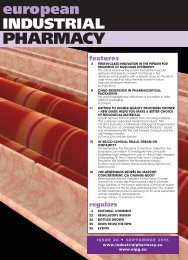PHARMACY
eip31-dec16
eip31-dec16
Create successful ePaper yourself
Turn your PDF publications into a flip-book with our unique Google optimized e-Paper software.
FORMULATION TECHNOLOGY CAN ENABLE ORAL DELIVERY OF NEW GENERATION MEDICINES<br />
continued<br />
drug-containing lipidic granules in<br />
a hydrophilic matrix coated with<br />
enteric acrylic copolymers. The<br />
coating delays the release until the<br />
tablet arrives at the intestine where<br />
the coating dissolves and the<br />
extended-release drug delivery<br />
begins. Release over the length of<br />
the colon allows for the topical<br />
application of the drug to the<br />
whole bowel surface affected by<br />
inflammation 78,79 .<br />
The tablet (Figure 3) is made by<br />
combining drug, a lipophilic matrixforming<br />
agent (for example, stearic<br />
acid, stearic acid/carnauba wax<br />
mixture or stearic acid/beeswax<br />
mixture) and an amphiphilic agent<br />
(for example, lecithin or diethylene<br />
glycol monomethyl ether), with a<br />
binder (low viscosity hydroxypropylcellulose<br />
or povidone) to form<br />
granules. These granules are<br />
blended with other non-functional<br />
excipients and the hydrophilic<br />
matrix-forming excipients (for<br />
example, hydroxypropylcellulose,<br />
carbomer, alginate), and optionally<br />
additional active ingredient<br />
(dependent on dose and drugrelease<br />
profile desired), and tablets<br />
are compressed from this blend.<br />
The tablets are then coated with<br />
enteric polymers, typically a mixture<br />
of methacrylic acid–methyl<br />
methacrylate copolymer (1:2) and<br />
methacrylic acid–methyl<br />
methacrylate copolymer (1:1) 79,80 .<br />
The innovators of this technology<br />
have successfully demonstrated the<br />
efficacy of infliximab (anti-TNFα)<br />
delivered topically (as an enema) to<br />
a very small number of human<br />
subjects as treatment for IBD, and<br />
have completed an initial<br />
demonstration of the feasibility of<br />
incorporating the monoclonal<br />
antibody into MMX technology oral<br />
dosage forms 81 .<br />
SmPill (LEDDS)<br />
Cyclosporine has been employed<br />
as therapy (principally by infusion)<br />
in IBD, notably in steroid refractory<br />
ulcerative colitis, but is associated<br />
with considerable toxicity, including<br />
seizures and fatal opportunistic<br />
infections. The availability of the<br />
oral microemulsion formulation has<br />
allowed for oral delivery and the<br />
targeting of low circulating<br />
cyclosporine levels to manage<br />
adverse events 82 . Minimising<br />
absorption and targeting drug<br />
release in the colon might offer an<br />
improved way of using cyclosporine<br />
for the treatment of IBD.<br />
A technology that allows the<br />
delivery of a solubilised form of a<br />
poorly water soluble drug to the<br />
colon has been applied to<br />
cyclosporine and this product has<br />
been studied in ulcerative colitis<br />
patients in Phase 2 trials with plans<br />
for Phase 3 trials advancing 83 . The<br />
technology, SmPill (“single multiple<br />
pill”) and its predecessor LEDDS<br />
(“liquid/emulsion drug delivery<br />
system”), involves the bringing<br />
together of two liquid streams as a<br />
concentric single flow, the inner<br />
stream being the drug dissolved in<br />
a suitable oil/surfactant and the<br />
outer stream being a hot<br />
gelatin/sorbitol solution. The<br />
concentric streams pass into a<br />
cooled immiscible liquid with<br />
vibration that breaks the stream<br />
into droplets yielding drug-insolution<br />
cores with a solidified<br />
gelatin/sorbitol outer shell. The soformed<br />
“minicapsules” are then<br />
coated with sustained release<br />
and/or enteric coating polymers.<br />
These can be ethyl cellulose or<br />
ammonio-methacrylate copolymer<br />
type B (sustained release), or a pH<br />
7.0 soluble proprietary acrylates<br />
copolymer enteric coating<br />
(Eudragit ® FS 30D) or mixture of<br />
ammonio-methacrylate copolymer<br />
type B and ammonio-methacrylate<br />
copolymer type A (sustainedrelease<br />
coating) before being<br />
coated with a pH 7.0 soluble<br />
proprietary acrylates copolymer<br />
enteric coating (Eudragit ® FS<br />
30D) 84 . The minicapsules can be<br />
administered in several ways, e.g.<br />
Incorporated into a unit dose<br />
dosage form such as filing into a<br />
hard gelatin capsule or provided as<br />
a sprinkle to add to food.<br />
The company involved in<br />
developing SmPill cyclosporine for<br />
ulcerative colitis is also developing<br />
a SmPill formulation for the<br />
treatment of Crohn’s disease.<br />
Some thoughts on the newer<br />
therapeutic entities and the<br />
role of GI-targeted site<br />
delivery technologies<br />
There is a significant group of new<br />
therapeutic entities being advanced<br />
for new IBD molecular targets and<br />
also new targeting delivery<br />
technologies being researched or in<br />
clinical trials. The desire for systemic<br />
delivery as opposed to local<br />
intestinal mucosa delivery remains<br />
debatable and the outcome may<br />
possibly depend on the<br />
independent molecular mechanism<br />
and its location on the epithelial cell<br />
surface, the epithelial layer, the<br />
lamina propria or submucosal<br />
tissue. However, the target product<br />
profile may change with each<br />
option and lead to changes in the<br />
therapeutic index. The example of<br />
the rectally administered, poorly<br />
absorbed ASO, cobitolimod,<br />
exemplifies the idea that local<br />
targeting can be beneficial. A key<br />
question is would targeting ASOs or<br />
other macromolecules orally, by<br />
hybrid-trigger approaches, expand<br />
their potential to both Crohn’s and<br />
ulcerative colitis indications,<br />
wherein minimal systemic exposure<br />
may be attractive. Some<br />
compounds may not be more<br />
effective as targeted delivery, for<br />
example, the possible requirement<br />
for systemic exposure in the case of<br />
ozanimod and laquinimod.<br />
Such new macromolecular entities<br />
(ASOs, peptides, proteins,<br />
monoclonal antibodies and their<br />
derivatives) face significantly greater<br />
biopharmaceutical risks to reach the<br />
desired cellular target than their<br />
small molecule counterparts. While<br />
the delivery system clearly plays a<br />
crucial role to ensure reproducible<br />
release at the right target location,<br />
the drug must remain intact and get<br />
rapidly absorbed to reach the<br />
desired cellular target location. This<br />
is not easily achievable for high<br />
molecular weight drugs, especially<br />
for targets deeper in the intestinal<br />
wall. Premature release exposes the<br />
macromolecule drug to chemical<br />
and enzymatic inactivation within<br />
minutes, as the intestinal enzymatic<br />
barrier designed to protect against<br />
14 european INDUSTRIAL <strong>PHARMACY</strong> December 2016 • Issue 31





